Interstitials in f.c.c. High Entropy Alloys
Abstract
1. Introduction
2. Methodology
3. Interstitial Strengthening
3.1. Carbon Doping—CoCrFeMnNi
3.2. Carbon Doping—FeNiMnAlCr Alloys
3.3. Carbon Doping—NiCoCr
3.4. Carbon Doping—Fe40Mn40Co10Cr10
3.5. Nitrogen Doping
3.6. Nitrogen/Oxygen Doping
3.7. Boron Doping
3.8. Hydrogen Doping
4. Discussion
4.1. Lattice Strain
4.2. Yield Strength
4.3. Work-Hardening Rate
4.4. Ductility
4.5. Hall–Petch Slope
5. Conclusions
- Carbon increases the yield strength at both room temperature and 77 K. This increase is greater than in traditional alloys for Fe40.4Ni11.3Mn34.8Al7.5Cr6. However, the data for CoCrFeMnNi and Fe40Mn40Co10Cr10 are scattered and it is not clear whether the strengthening is greater than for traditional alloys.
- The yield strength increase arises from the lattice strain produced by the interstitial, but there is no simple correlation between the lattice strain and the yield strength increase, indicating that other factors are also important.
- There is a weak grain size dependence of both the ductility and work-hardening rate in both undoped and carbon-doped CoCrFeMnNi for grain sizes greater than the order of a few microns with smaller grain sizes showing the lower values. Below ~1 µm there is rapid decrease in ductility for both undoped and carbon-doped CoCrFeMnNi, and, at least for the undoped HEA, the WHR shows a sharp decrease at grain sizes <2 µm. Nitrogen-doped NiCoCr also showed a decrease in both ductility and WHR with decreasing grain size [11]. This is a phenomenon worth examining in other HEAs, and may be related to a change in deformation mechanism at small grain sizes as seen in Fe40.4Ni11.3Mn34.8Al7.5Cr6 [40].
- The effects of carbon on ductility are less clear. In many studies, carbon produced small decreases in elongation or little change while in others an increase in ductility has been observed. Thus, the effects may be system specific and depend on how carbon influences the deformation mechanisms.
- The effects of carbon on the work-hardening are also unclear. Some studies indicate the insubstantial effect of carbon on the work-hardening rate whereas some have shown large increases, which are related to changes in deformation behavior.
- Carbon almost doubles the Hall–Petch strengthening in CoCrFeMnNi (the only material for which data is available), suggesting substantial carbon segregation to the grain boundaries. Thus, carbon can be an effective strengthener both by increasing the lattice resistance and the grain boundary strength.
Acknowledgments
Conflicts of Interest
References
- Cantor, B.; Chang, I.T.H.; Knight, P.; Vincent, A.J.B. Microstructural development in equiatomic multicomponent alloys. Mater. Sci. Eng. A 2004, 375–377, 213–218. [Google Scholar] [CrossRef]
- Yeh, J.-W.; Chen, S.-K.; Lin, S.-J.; Gan, J.-Y.; Chin, T.-S.; Shun, T.-T.; Tsau, C.-H.; Chang, S.Y. Nanostructured High-Entropy Alloys with Multiple Principal Elements: Novel Alloy Design Concepts and Outcomes. Adv. Eng. Mater. 2004, 6, 299–303. [Google Scholar] [CrossRef]
- Otto, F.; Dlouhý, A.; Pradeep, K.G.; Kubenova, M.; Raabe, D.; Eggeler, G.; George, E.P. Decomposition of the single-phase high-entropy alloy CrMnFeCoNi after prolonged anneals at intermediate temperatures. Acta Mater. 2016, 112, 40–52. [Google Scholar] [CrossRef]
- Wang, Z.; Baker, I. Effects of annealing and thermo-mechanical treatment on the microstructures and mechanical properties of a C-doped FeNiMnAl medium-entropy alloy. Mater. Sci. Eng. A 2017, 693, 101–110. [Google Scholar] [CrossRef]
- Schulson, E.M.; Weihs, T.P.; Baker, I.; Frost, H.J.; Horton, J.A. Boron-Induced Grain Boundary Accommodation of Slip in Ni3Al. Scr. Metall. 1985, 19, 1497–1498. [Google Scholar] [CrossRef]
- Schulson, E.M.; Weihs, T.P.; Baker, I.; Frost, H.J.; Horton, J.A. Grain Boundary Accommodation of Slip in Ni3Al Containing Boron. Acta Metall. 1986, 34, 1395–1399. [Google Scholar] [CrossRef]
- Khadkikar, P.S.; Vedula, K.V.; Shabel, B.S. The Role of Boron in Ductilizing Ni3Al. Met. Trans. 1987, 18, 425–428. [Google Scholar] [CrossRef]
- Li, X.; Baker, I. The Effect of Boron on the Hall-Petch Behavior of Fe-45Al. Scr. Metal. Mat. 1996, 34, 1219–1223. [Google Scholar] [CrossRef]
- Floreen, S.; Westbrook, J.H. Grain boundary segregation and the grain size dependence of strength of nickel-sulfur alloys. Acta Metall. 1969, 17, 1175–1181. [Google Scholar] [CrossRef]
- Shang, Y.Y.; Wu, Y.; He, J.Y.; Zhu, X.Y.; Liu, S.F.; Huang, H.L.; An, K.; Chen, Y.; Jiang, S.H.; Wang, H.; et al. Solving the strength-ductility tradeoff in the medium-entropy NiCoCr alloy via interstitial strengthening of carbon. Intermetallics 2019, 106, 77–87. [Google Scholar] [CrossRef]
- Moravcik, I.; Hadraba, H.; Li, L.; Dlouhy, I.; Raabe, D.; Li, Z. Yield strength increase of a CoCrNi medium entropy alloy by interstitial nitrogen doping at maintained ductility. Scr. Mater. 2020, 178, 391–397. [Google Scholar] [CrossRef]
- Song, M.Z.; Zhou, R.; Gu, J.; Wang, Z.; Ni, S.; Liu, Y. Nitrogen induced heterogeneous structures overcome strength-ductilitytrade-off in an additively manufactured high-entropy alloy. Appl. Mater. Today 2019, 18. [Google Scholar] [CrossRef]
- Cordero, Z.C.; Knight, B.E.; Schuh, C.A. Six decades of the Hall–Petch effect–a survey of grain-size strengthening studies on pure metals. Int. Mater. Rev. 2016, 61, 495–512. [Google Scholar] [CrossRef]
- Schneider, M.; George, E.P.; Manescau, T.J.; Záležák, T.; Hunfeld, J.; Dlouhý, A.; Eggeler, G.; Laplanche, G. Analysis of strengthening due to grain boundaries and annealing twin boundaries in the CrCoNi medium-entropy alloy. Int. J. Plast. 2020, 124, 155–169. [Google Scholar] [CrossRef]
- Tabor, D. Hardness of Metals; Clarendon Press: Oxford, UK, 1951; ISBN 978-0198507765. [Google Scholar]
- Patriarca, L.; Ojha, A.; Sehitoglu, H.; Chumlyakov, Y.I. Slip nucleation in single crystal FeNiCoCrMn high entropy alloy. Scr. Mater. 2016, 112, 54–57. [Google Scholar] [CrossRef]
- Abuzaid, W.; Sehitoglu, H. Criticial resolved shear stress for slip and twin nucleation in single crystalline FeNiCoCrMn high entropy alloy. Mater. Charact. 2017, 129, 288–299. [Google Scholar] [CrossRef]
- Otto, F.; Dlouhý, A.; Somsen, C.; Bei, H.; Eggeler, G.; George, E.P. The influences of temperature and microstructure on the tensile properties of a CoCrFeMnNi high-entropy alloy. Acta Mater. 2013, 61, 5743–5755. [Google Scholar] [CrossRef]
- Sun, S.J.; Tian, Y.Z.; Lin, H.R.; Dong, X.G.; Wang, Y.H.; Wang, Z.J.; Zhang, Z.F. Temperature dependence of the Hall-Petch relationship in CoCrFeMnNi high-entropy alloy. J. Alloys Compd. 2019, 806, 992–998. [Google Scholar] [CrossRef]
- Liu, G.; Lu, D.H.; Liu, X.W.; Liu, F.C.; Yang, Q.; Du, H.U.; Hu, Q.; Fan, Z.T. Solute segregation effect on grain boundary migration and Hall–Petch relationship in CrMnFeCoNi high-entropy alloy. Mater. Sci. Tech. 2019, 35, 500–508. [Google Scholar] [CrossRef]
- Stepanov, N.D.; Shaysultanov, D.G.; Chernichenko, R.; Yu Yurchenko, N.; Zherebtsov, S.V.; Tikhonovsky, M.A.; Salishchev, G.A. Effect of thermomechanical processing on microstructure and mechanical properties of the C-containing CoCrFeNiMn high entropy alloy. J. Alloys Compd. 2017, 693, 394–405. [Google Scholar] [CrossRef]
- Laplanche, G.; Kostka, A.; Horst, O.M.; Eggeler, G.; George, E.P. Microstructure evolution and critical stress for twinning in the CrMnFeCoNi high-entropy alloy. Acta Mater. 2016, 118, 152–163. [Google Scholar] [CrossRef]
- Thurston, K.V.S.; Hohenwarter, A.; Laplanche, G.; George, E.P.; Gludovatz, B.; Ritchie, R.O. On the onset of deformation twinning in the CrFeMnCoNi high-entropy alloy using a novel tensile specimen geometry. Intermetallics 2019, 110, 106469. [Google Scholar] [CrossRef]
- Liu, W.H.; Wu, Y.; He, J.Z.; Nieh, T.G.; Lu, T.P. Grain growth and the Hall–Petch relationship in a high-entropy FeCrNiCoMn alloy. Scr. Mater. 2013, 68, 526–529. [Google Scholar] [CrossRef]
- Stepanov, N.D. Personal communication by email. 21 April 2020. [Google Scholar]
- Ikeda, I.; Tanaka, I.; Neugebauer, J.; Körmann, F. Impact of interstitial C on phase stability and stacking-fault energy of the CrMnFeCoNi high-entropy alloy. Phys. Rev. Mater. 2019, 3, 113603. [Google Scholar] [CrossRef]
- Wu, Z.; Parish, Z.M.; Bei, H. Nano-twin mediated plasticity in C-containing FeNiCoCrMn high entropy alloys. J. Alloys Compd. 2015, 647, 815–822. [Google Scholar] [CrossRef]
- Chen, J.; Yao, Z.; Wang, X.; Lu, Y.; Wang, X.; Liu, Y.; Fan, X. Effect of C content on microstructure and tensile properties of as-cast CoCrFeMnNi high entropy alloy. Mater. Chem. Phys. 2018, 210, 136–145. [Google Scholar] [CrossRef]
- Li, Z. Interstitial equiatomic CoCrFeMnNi high-entropy alloys: C content, microstructure, and compositional homogeneity effects on deformation behavior. Acta Mater. 2019, 164, 400–412. [Google Scholar] [CrossRef]
- Cheng, H.; Wang, H.Y.; Xie, Y.C.; Tang, Q.H.; Dai, P.Q. Controllable fabrication of a carbide-containing FeCoCrNiMn high-entropy alloy: Microstructure and mechanical properties. Mater. Sci. Tech. 2017, 33, 2032–2039. [Google Scholar] [CrossRef]
- Ko, J.Y.; Hong, S.I. Microstructural evolution and mechanical performance of C-containing CoCrFeMnNi-C high entropy alloys. J. Alloys Compd. 2018, 743, 115–125. [Google Scholar] [CrossRef]
- Guo, L.; Ou, X.Q.; Ni, S.; Liu, Y.; Song, M. Effects of C on the microstructures and mechanical properties of FeCoCrNiMn high entropy alloys. Mater. Sci. Eng. A 2019, 746, 356–362. [Google Scholar] [CrossRef]
- Klimova, M.V.; Shaysultanov, D.G.; Chernichenko, R.S.; Sanin, V.N.; Stepanov, N.D.; Zherebtsov, S.V.; Belyakov, A.N. Recrystallized microstructures and mechanical properties of a C-containing CoCrFeNiMn-type high-entropy alloy. Mat. Sci. Eng. A 2019, 740–741, 201–210. [Google Scholar] [CrossRef]
- Park, J.M.; Choe, J.; Kim, J.G.; Bae, J.W.; Moon, J.; Yang, S.; Kim, K.T.; Yu, J.-H.; Kim, H.S. Superior tensile properties of 1%C-CoCrFeMnNi high-entropy alloy additively manufactured by selective laser melting. Mater. Res. Lett. 2020, 8, 1–7. [Google Scholar] [CrossRef]
- Stepanov, N.D.; Yurchenko, N.Y.; Tikhonovsky, M.A.; Salishchev, G.A. Effect of C content and annealing on structure and hardness of the CoCrFeNiMn-based high entropy alloys. J. Alloys Compd. 2016, 687, 59–71. [Google Scholar] [CrossRef]
- Cheng, H.C.; Chen, W.; Liu, X.Q.; Tang, Q.H.; Xie, Y.C.; Dai, P.Q. Effect of Ti and C additions on the microstructure and mechanical properties of the FeCoCrNiMn high-entropy alloy. Mater. Sci. Eng. A 2018, 719, 192–198. [Google Scholar] [CrossRef]
- Klimova, M.; Stepanov, N.; Shaysultanov, D.; Chernichenko, R.; Yurchenko, N.; Sanin, V.; Zherebtsov, S. Microstructure and Mechanical Properties Evolution of the Al, C-Containing CoCrFeNiMn-Type High-Entropy Alloy during Cold Rolling. Materials 2018, 11, 53. [Google Scholar] [CrossRef]
- Klimova, M.V.; Semenyuk, A.O.; Shaysultanov, D.G.; Salishchev, G.A.; Zherebtsov, S.V.; Stepanov, N.D. Effect of C on cryogenic tensile behavior of CoCrFeMnNi-type high entropy alloys. J. Alloys Compd. 2019, 811, 152000. [Google Scholar] [CrossRef]
- Wang, Z.; Baker, I.; Cai, Z.; Chen, S.; Poplawsky, J.D.; Guo, W. The effect of interstitial C on the mechanical properties and dislocation substructure evolution in Fe40.4Ni11.3Mn34.8Al7.5Cr6 high entropy alloys. Acta Mater. 2016, 68, 228–239. [Google Scholar] [CrossRef]
- Wang, Z.; Baker, I.; Guo, W.; Poplawsky, J.D. The effect of carbon on the microstructures, mechanical properties, and deformation mechanisms of thermo-mechanically treated Fe40.4Ni11.3Mn34.8Al7.5Cr6 high entropy alloys. Acta Mater. 2017, 126, 346–360. [Google Scholar] [CrossRef]
- Labusch, R. A Statistical Theory of Solid Solution Hardening. Phys. Stat. Sol. 1970, 41, 659. [Google Scholar] [CrossRef]
- Wei, R.; Sun, H.; Han, Z.H.; Chen, C.; Wang, T.; Guan, S.K.; Li, F.S. Strengthening of Fe40Mn40Co10Cr10 High Entropy Alloy Via Mo/C Alloying. Mater. Lett. 2018, 219, 85–88. [Google Scholar] [CrossRef]
- Chen, L.B.; Wei, R.; Tang, K.; Zhang, J.; Jiang, F.; He, L.; Sun, L. Heavy C alloyed FCC-structured high entropy alloy with excellent combination of strength and ductility. Mater. Sci. Eng. 2018, 716, 150–156. [Google Scholar] [CrossRef]
- Li, Z.; Tasan, C.C.; Springer, H.; Gault, B.; Raabe, D. Interstitial atoms enable joint twinning and transformation induced plasticity in strong and ductile high-entropy alloys. Sci. Rep. 2017, 7, 40704. [Google Scholar] [CrossRef] [PubMed]
- Li, Z.; Pradeep, K.G.; Deng, Y.; Raabe, D.; Tasan, C.C. Metastable high-entropy dual-phase alloys overcome the strength–ductility trade-off. Nature 2016, 534, 227–230. [Google Scholar] [CrossRef]
- Zhang, W.; Yan, D.; Lu, W.; Li, Z. Carbon and nitrogen co-doping enhances phase stability and mechanical properties of a metastable high-entropy alloy. J. Alloys Compd. 2020, 831, 154799. [Google Scholar] [CrossRef]
- Yoshida, S.; Bhattacharjee, T.; Bai, Y.; Tsuji, N. Friction stress and Hall-Petch relationship in CoCrNi equi-atomic medium entropy alloy processed by severe plastic deformation and subsequent annealing. Scr. Mater. 2017, 134, 33–36. [Google Scholar] [CrossRef]
- Uzer, B.; Picak, S.; Liu, J.; Jozaghi, T.; Canadinc, D.; Karaman, I.; Chumlyakov, Y.I.; Kireeva, I. On the mechanical response and microstructure evolution of NiCoCr single crystalline medium entropy alloys. Mater. Res. Lett. 2018, 6, 442–449. [Google Scholar] [CrossRef]
- Meng, F.; Baker, I. Nitriding of a High Entropy FeNiMnAlCr Alloy. J. Alloys Compd. 2015, 645, 376–381. [Google Scholar] [CrossRef]
- Feng, H.; Li, H.; Wu, X.; Jiang, Z.; Zhao, S.; Zhang, T.; Xu, D.; Zhang, S.; Zhu, H.; Zhang, B.; et al. Effect of nitrogen on corrosion behaviour of a novel high nitrogen medium-entropy alloy CrCoNiN manufactured by pressurized metallurgy. J. Maters. Sci. Tech. 2018, 34, 1781–1790. [Google Scholar] [CrossRef]
- Laurent-Brocq, M.; Sauvage, X.; Akhatova, A.; Perriere, L.; Leroy, E.; Champion, Y. Precipitation and hardness of Citrides in a CrMnFeCoNi high entropy alloy. Adv. Eng. Mater. 2017, 19, 201600715. [Google Scholar] [CrossRef]
- Youssef, K.M.; Zaddach, A.J.; Niu, C.; Irving, D.L.; Koch, C.C. A Novel Low-Density, High-Hardness, High-entropy Alloy with Close-packed Single-phase Nanocrystalline Structures. Mater. Res. Lett. 2015, 3, 95–99. [Google Scholar] [CrossRef]
- Hakan, G.; Mohsen, G. A novel medium entropy alloy based on iron-manganese-aluminum- nickel: Influence of boron addition on phase formation, microstructure, and mechanical properties. Mater. Res. Express 2020, 7, 016516. [Google Scholar] [CrossRef]
- Xiaotao, L.; Wenbin, L.; Lijuan, M.; Jinling, L.; Jing, L.; Jianzhong, C. Effect of Boron on the microstructure, Phase Assemblage and Wear Properties of Al0.5CoCrCuFeNi High-Entropy Alloy. Rare Metal Mater. Eng. 2016, 45, 2201–2207. [Google Scholar] [CrossRef]
- Wang, Z.W.; Baker, I. Interstitial strengthening of a f.c.c. FeNiMnAlCr high entropy alloy. Mater. Lett. 2016, 180, 153–156. [Google Scholar] [CrossRef]
- Hou, L.; Hui, J.T.; Yao, Y.H.; Chen, J.; Liu, J.N. Effects of Boron Content on microstructure and mechanical properties of AlFeCoNiBx High Entropy Alloy Prepared by vacuum arc melting. Vacuum 2019, 164, 212–218. [Google Scholar] [CrossRef]
- Luo, H.; Lia, Z.; Raabe, D. Hydrogen enhances strength and ductility of an equiatomic high entropy alloy. Sci. Rep. 2017, 7, 9892. [Google Scholar] [CrossRef] [PubMed]
- Gavrilyuk, V.G.; Berns, H. High Nitrogen Steels: Structure, Properties, Manufacture, Applications; Springer: Berlin/Heidelberg, Germany, 1999; ISBN 978-3-662-03760-7. [Google Scholar]
- Yang, E.E. The Effect of C Content on the Mechanical Properties and Microstructural Evolution of Fe-22Mn-C TWIP/TRIP Steels. Ph.D. Thesis, McMaster University, Hamilton, ON, Canada, August 2010. [Google Scholar]
- Bouaziz, O.; Zurob, H.; Chehab, B.; Embury, J.D.; Allain, S.; Huang, M. Effect of chemical composition on work hardening of FeMnC TWIP steels. Mater. Sci. Tech. 2011, 27, 707–709. [Google Scholar] [CrossRef]
- Baker, I.; Meng, F. Lamellar Coarsening in Fe28Ni18Mn33Al21 and its Influence on Room Temperature Tensile Behavior. Acta Mater. 2015, 95, 124–131. [Google Scholar] [CrossRef]
- Takeda, K.; Nakada, N.; Tsuchiyama, T.; Takaki, S. Effect of interstitial elements on Hall-Petch coefficient of ferritic iron. ISIJ Int. 2008, 48, 1122–1125. [Google Scholar] [CrossRef]
- Araki, S.; Mashima, K.; Masumura, T.; Tsuchiyama, T.; Takaki, S.; Ohmura, T. Effect of grain boundary segregation of carbon on critical grain boundary strength of ferritic steel. Scr. Mater. 2019, 169, 38–41. [Google Scholar] [CrossRef]
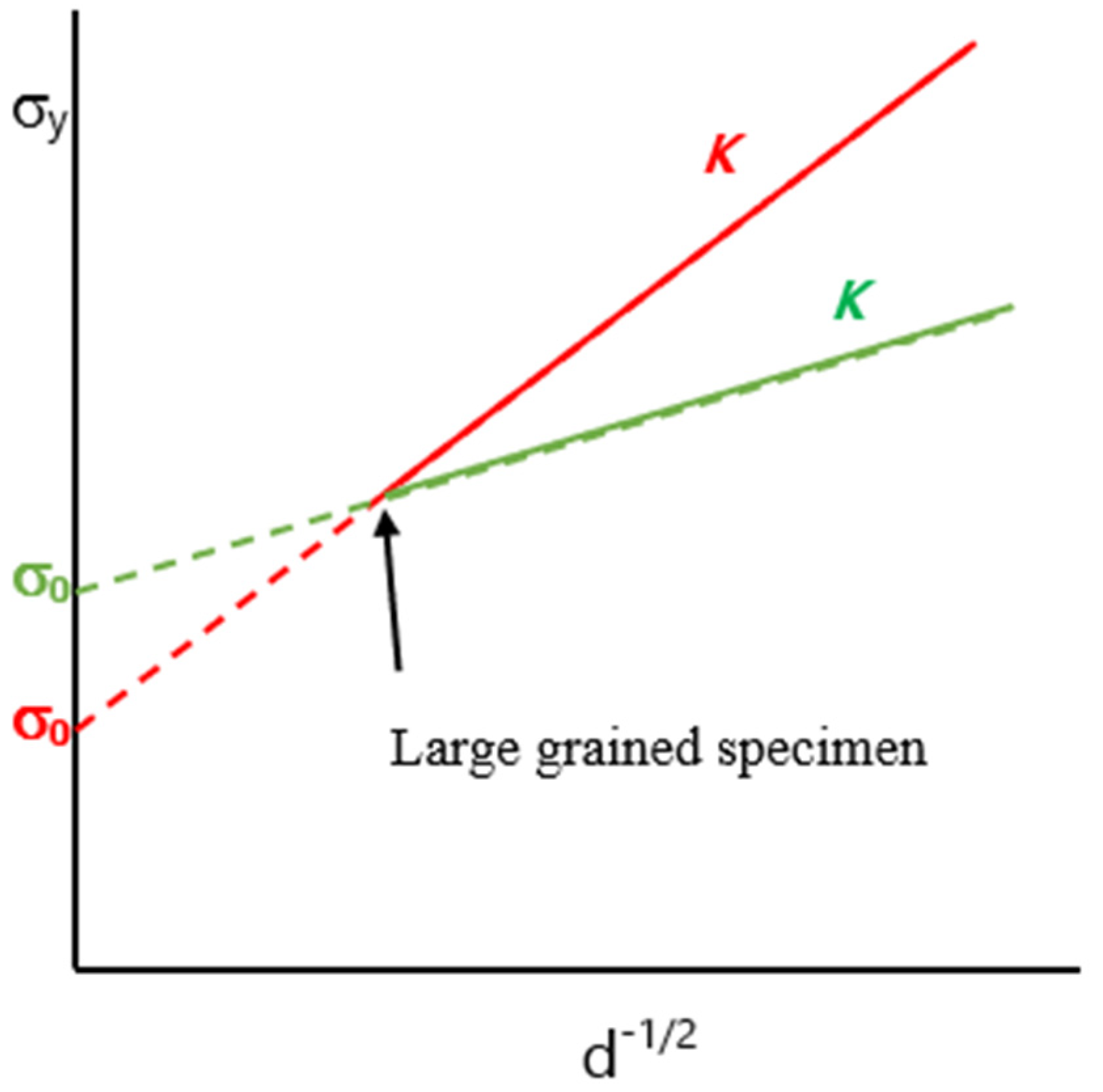
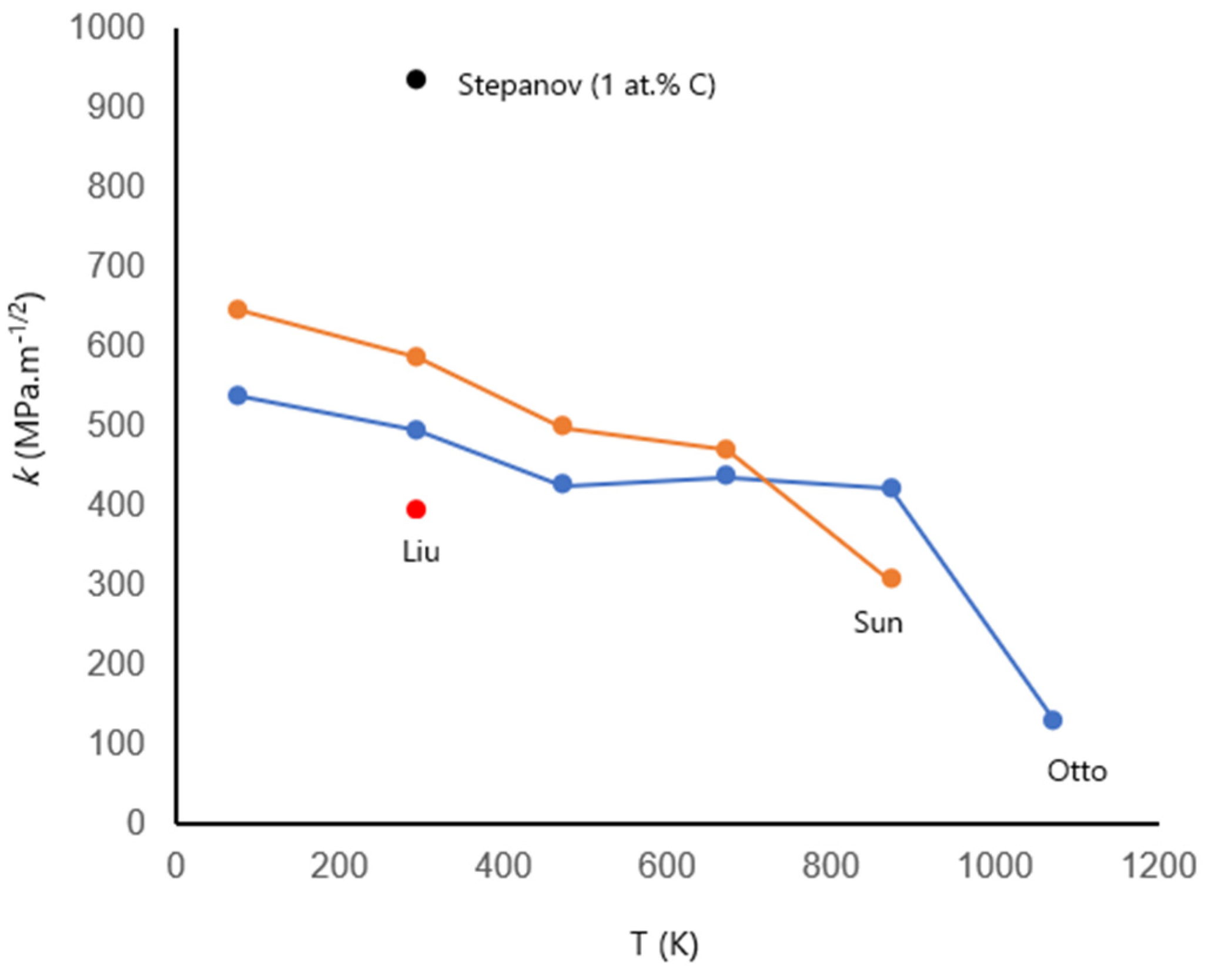
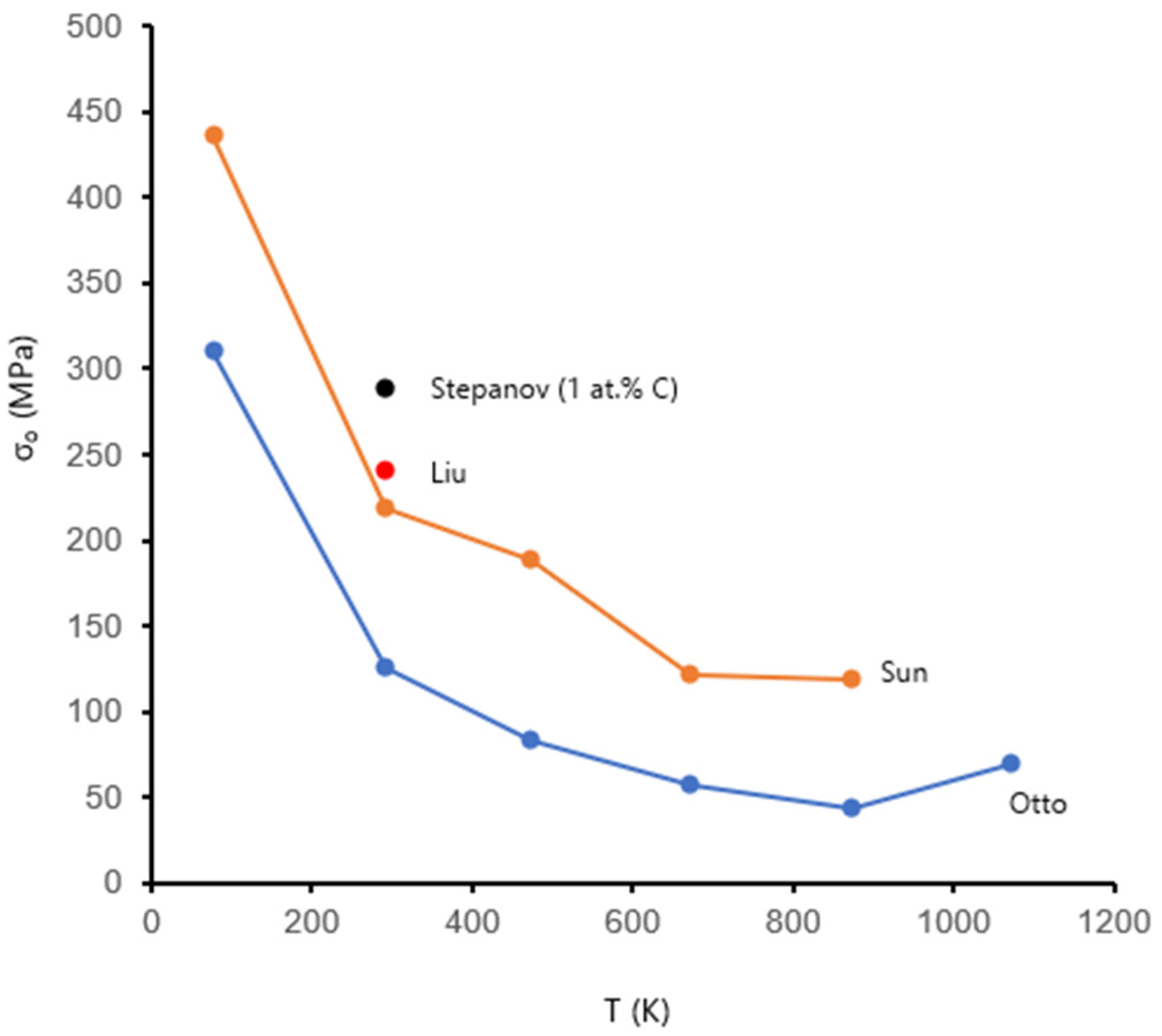
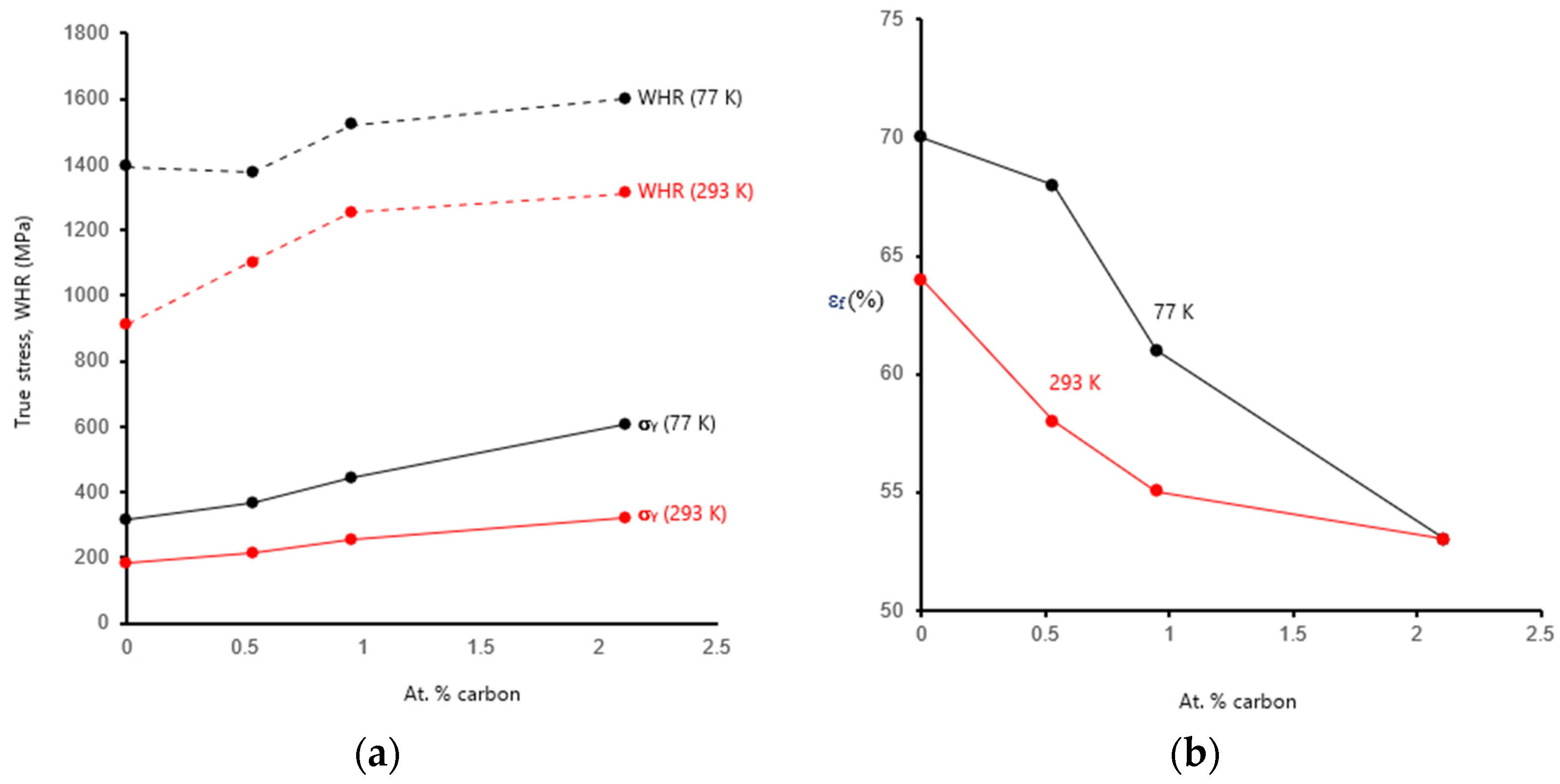
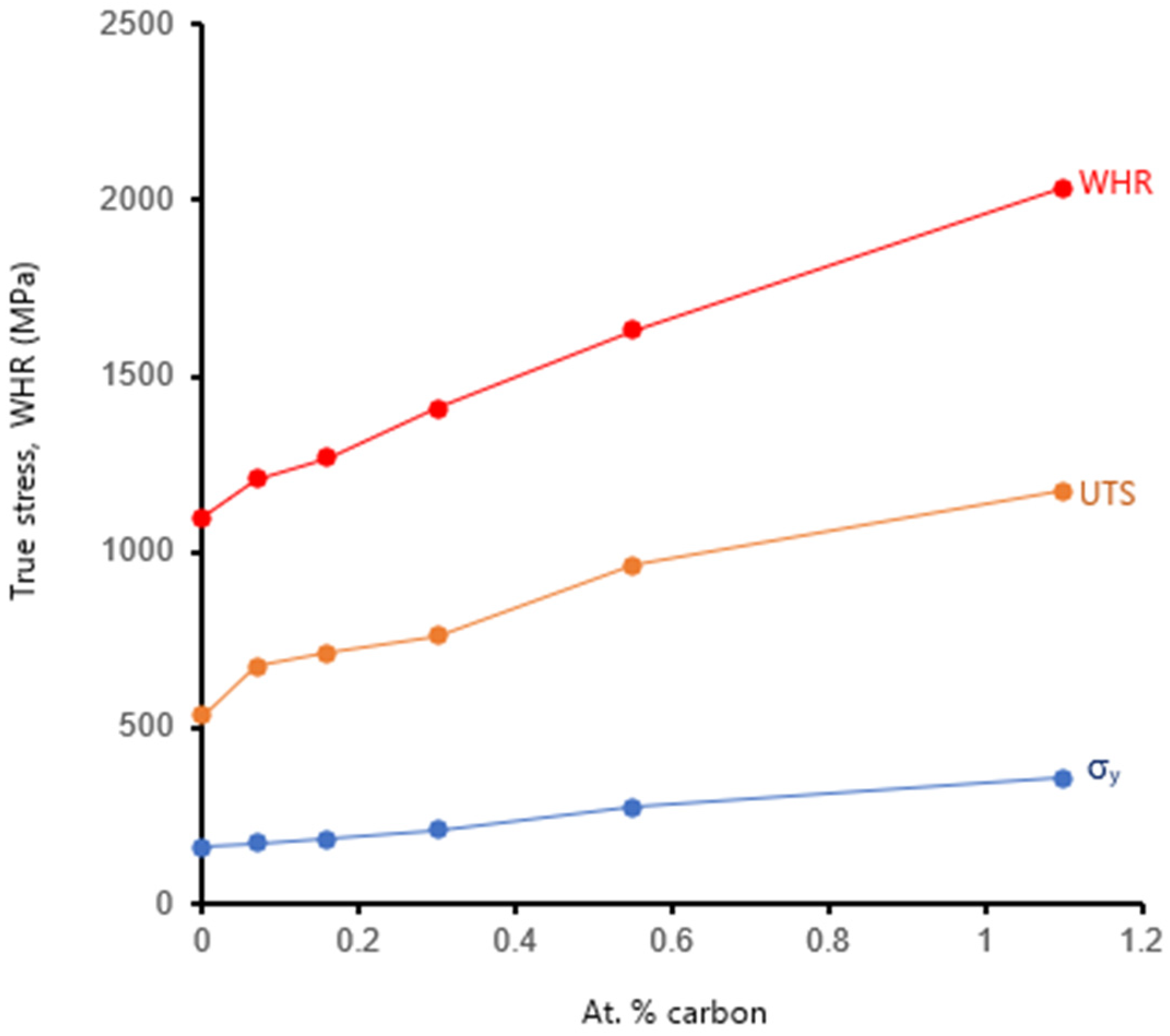
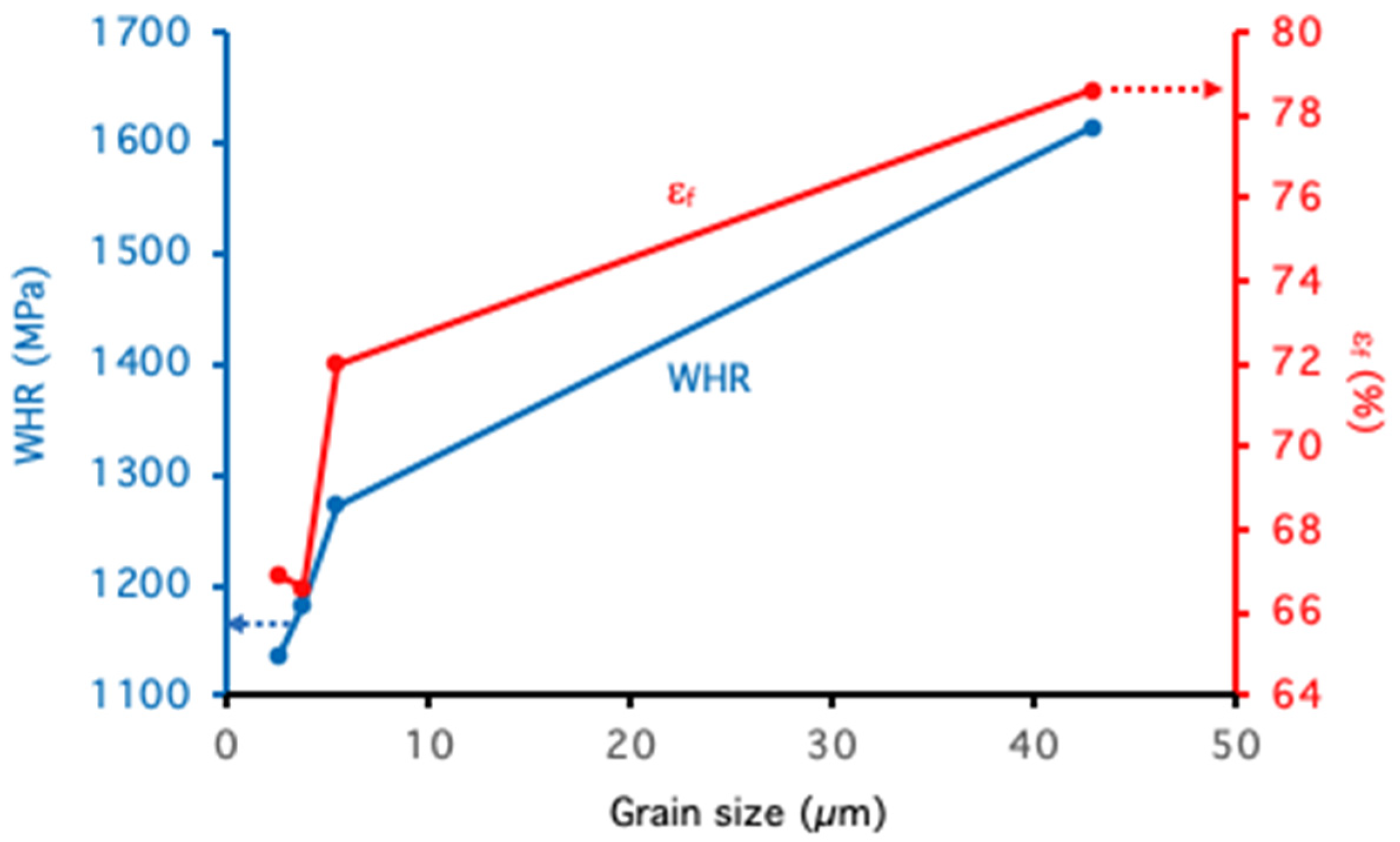
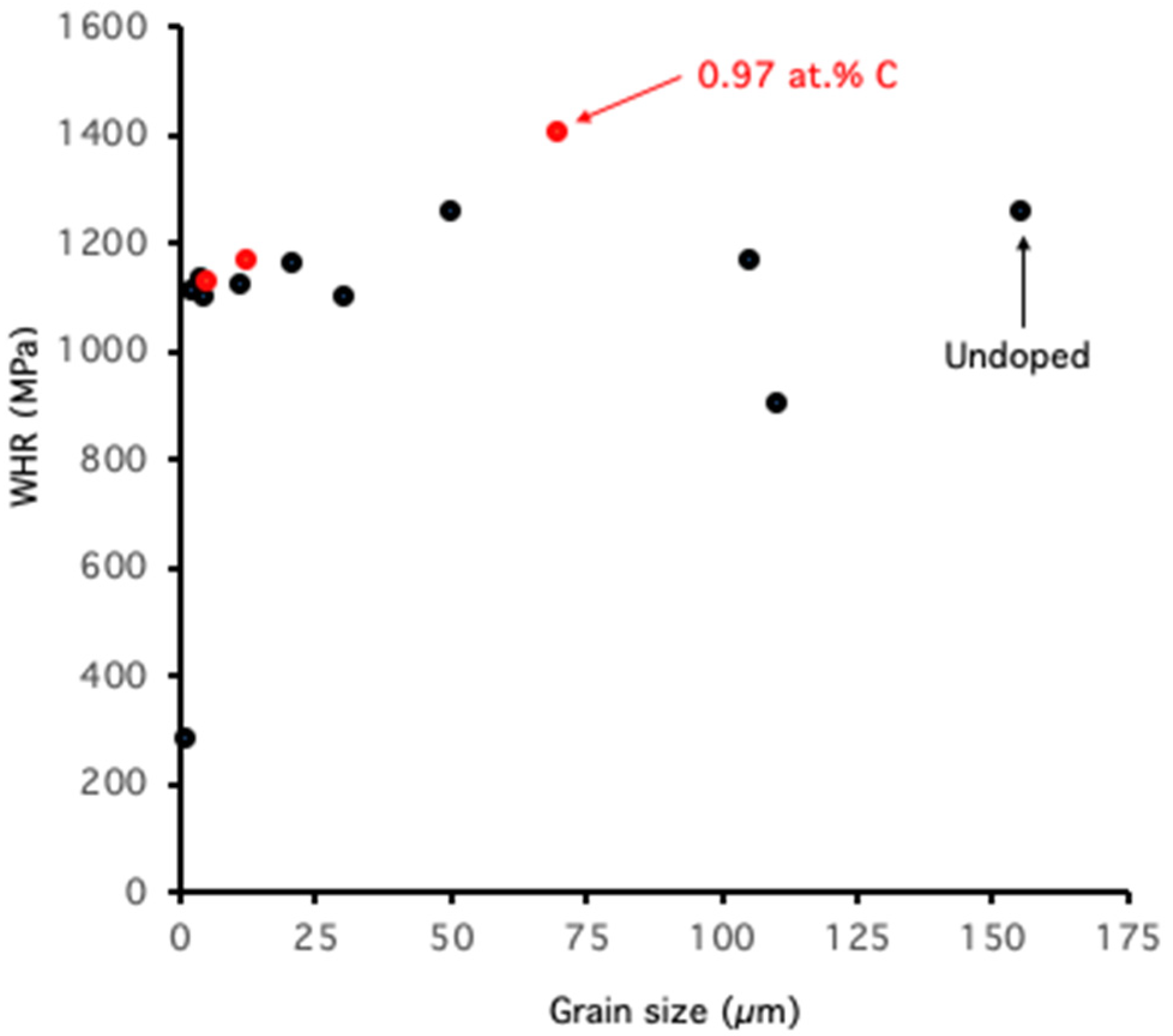
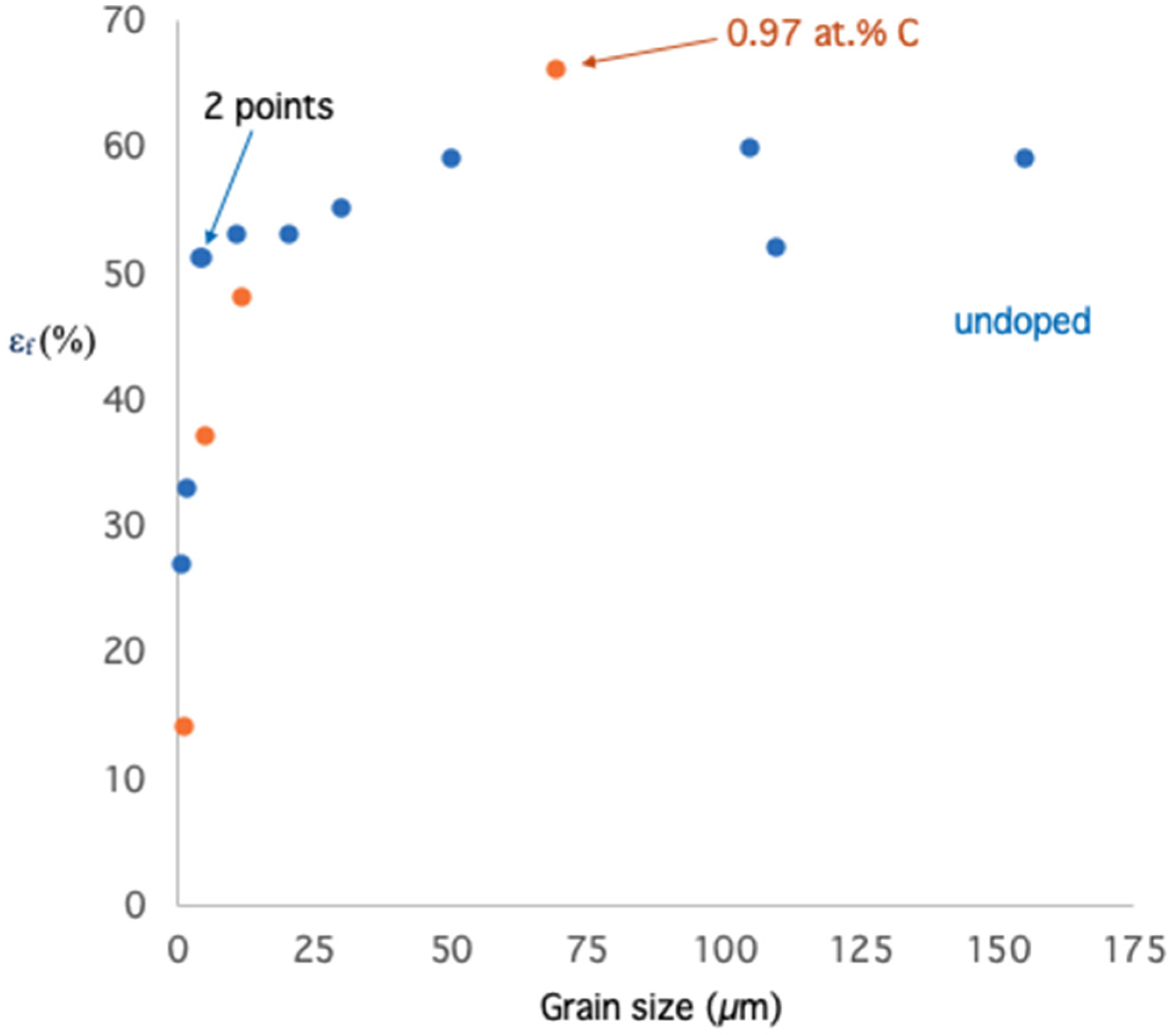
| T (K) | σ0 (MPa) Otto et al. [18] | σ0 (MPa) Sun et al. [19] | σ0 (MPa) Liu et al. [20] | k (MPa·μm−1/2) Otto et al. [18] | k (MPa·μm−1/2) Sun et al. [19] | k (MPa·μm−1/2) Liu et al. [20] |
|---|---|---|---|---|---|---|
| 77 | 310 | 436 | - | 538 | 645 | - |
| 293 | 125 | 218 | 214 | 494 | 586 | 394 |
| 473 | 83 | 188 | - | 425 | 497 | - |
| 673 | 57 | 121 | - | 436 | 469 | - |
| 873 | 43 | 119 | - | 421 | 306 | - |
| 1073 | 69 | - | - | 127 | - | - |
| T(K)/Reference | σ0 Otto et al. [18] | σ0 Sun et al. [19] | σ0 Liu et al. [20] | σ0 Stepanov et al. [21] | σy Wu et al. [27] | σy Wu et al. [27] | σy Chen et al. [28] | σy Chen et al. [28] | σy Li [29] |
|---|---|---|---|---|---|---|---|---|---|
| 77 | 310 | 436 | - | - | 350 | 510 (0.5C) | - | - | - |
| 293 | 125 | 218 | 214 | 288 (1C) | 165 | 225 (0.5C) | 250 | 310 (1.1C) | 200 (0.00, 0.25, 0.53, 0.9) |
| at. % Carbon | σy (MPa) | UTS (MPa) | WHR (MPa) | εf (%) | Reference |
|---|---|---|---|---|---|
| Undoped | 213 ± 7 | 471 ± 11 | 893 | 57.7 ± 2.5 | [43] |
| Undoped | 240 | 480 | 842 | 56 | [42] |
| 0.75 | 400 | 703 | 1197 | 44 | [42] |
| 1.0 | 520 | 818 | 1240 | 40 | [42] |
| 2.2 | 310 ± 6 | 650 ± 17 | 1135 | 62.9 ± 1.4 | [43] |
| 3.3 | 422 ± 7 | 787 ± 21 | 1128 | 77.8 ± 1.5 | [43] |
| Alloy | Interstitial | Δa/(Δc × a) | Δσy (MPa) | Reference |
|---|---|---|---|---|
| Fe40Mn40Co10Cr10 | C | 0.22 | 60 | [42] |
| NiCoCr | C | 0.22 | 140 | [10] |
| NiCoCr | N | 0.24 | 81 | [11] |
| CoCr0.25FeMnNi | C | 0.30 | 64 | [38] |
| FeCoNiCr | N | 0.39 | - | [12] |
| Fe40.4Ni11.3Mn34.8Al7.5Cr6 | C | 0.78 | 184 | [39] |
© 2020 by the author. Licensee MDPI, Basel, Switzerland. This article is an open access article distributed under the terms and conditions of the Creative Commons Attribution (CC BY) license (http://creativecommons.org/licenses/by/4.0/).
Share and Cite
Baker, I. Interstitials in f.c.c. High Entropy Alloys. Metals 2020, 10, 695. https://doi.org/10.3390/met10050695
Baker I. Interstitials in f.c.c. High Entropy Alloys. Metals. 2020; 10(5):695. https://doi.org/10.3390/met10050695
Chicago/Turabian StyleBaker, Ian. 2020. "Interstitials in f.c.c. High Entropy Alloys" Metals 10, no. 5: 695. https://doi.org/10.3390/met10050695
APA StyleBaker, I. (2020). Interstitials in f.c.c. High Entropy Alloys. Metals, 10(5), 695. https://doi.org/10.3390/met10050695





